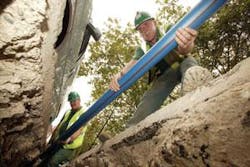Water shortages adds urgency to Thames Water leakage strategy
Camilla Anderson
British weather may never be predictable, but forecasts of another winter of below average rainfall have water companies tightening their belts. Thames Water, the UK’s largest water and wastewater services company, focuses on mains replacement efforts, leakage find-and-fix programs, and public education to conserve water.
Following 11 consecutive months of below-average rainfall, UK water companies braced themselves for a difficult winter, the consequences of which will be felt in the summer of 2006.
Despite storms in early September, the London and Thames Valley region received only 83% of its average rainfall. Since November 2004, the London region has seen only two-thirds of its anticipated amount of rain, leaving many rivers and aquifers well below normal levels. For Thames Water, the prospect of water shortages next year has added extra impetus to the company’s leakage strategy.
Photo by Thames Water
Tony Rachwal, director of research and development at Thames, reported that the company is hoping for well above the normal average monthly winter rainfall of 66 mm. “But, following a very dry September and a very warm October, it’s important that as much leakage as possible is stemmed before next summer. While water demand was better than anticipated following the success of our media campaign urging Londoners to minimize water wastage, we want to avoid restrictions or drought orders in 2006 in the event of another dry winter,” he explained.
Water shortage is among the most serious threats to quality of life in the UK, however the perils of shortages are not just confined to southern England. Many other regions must address issues of efficiency at a time when water companies are faced with increases in demand from growing population. Thames Water serves more than eight million customers from Kent and Essex in the east and to the edges of Gloucestershire in the west. London is expected to grow by 800,000 people by 2016.
The UK government plans to expand housing in the South East and along the Thames Gateway, which is placing additional strain on an area with few large rivers where most water resources are taken from aquifers.
Thames Water faces two challenges -- population growth and climate change - and both are placing stress on water resources, Rachwal contends. “Combating leakage and improving efficiency are top priorities,” he added.
Accumulated run-off figures for November 2004 to August 2005 are among the lowest ever recorded in the region, affecting groundwater and delaying the starts to the natural winter recharge period.
High leakage levels are a major problem in London. Mark Simister, the company’s leakage strategy manager reported, “Leakage outside the capital has been significantly reduced over the last few years and is at its lowest level since we began reporting it in 1996.”
Thames Water began its mains replacement work three years ago, which is helping to reduce leakage, but London’s ageing, corroded pipe network significantly aggravates the situation. Half of the mains are more than 100 years old and a third are more than 150 years old. Ancient cast iron pipes, rather than being bolted together, are linked by some 10 million sliding joints across the whole system. “Originally designed to absorb the movement when pipes contract and expand in different weather, these joints withstand water temperatures that range between four degrees Celsius in the winter and up to 22 degrees in the summer. However, age and corrosion have taken their toll and the joints too are prone to seizing up, adding to seasonal stress and strain on parts of the pipe network,” Tony Rachwal explained.
Currently, the company has more than 300 two-man teams detecting or fixing leaks across the region at a rate of 200 repairs a day, however London’s very foundations create problems. The clay upon which London is built easily expands and contracts, which puts unusual stresses on pipes. Heavy traffic and the city’s many concrete surfaces make leaks trickier to detect and repair.
Tony Rachwal explained: “We are developing novel technologies that assess the condition of pipes from the inside to accurately target the places where renewal is better than repair and replacement activities. However, we must continue with the agenda of find and fix, mending leaks that are visible above the ground as quickly as possible and using advanced listening devices for detecting and repairing a further 40,000-plus leaks underground each year.”
Thames Water renewed more than 165 miles of Victorian water mains in 14 London boroughs at a cost of more than 169 million Euros, and plans to invest 734 million Euros to upgrade a further 850 miles within the next four years. In the meantime, the company plans to encourage consumers to use water more efficiently, while continuing to reduce water leakage throughout the London and Thames Valley region.
Author’s Note
Camilla Anderson is an environment specialist at IMS Consulting based in Bristol, UK.

